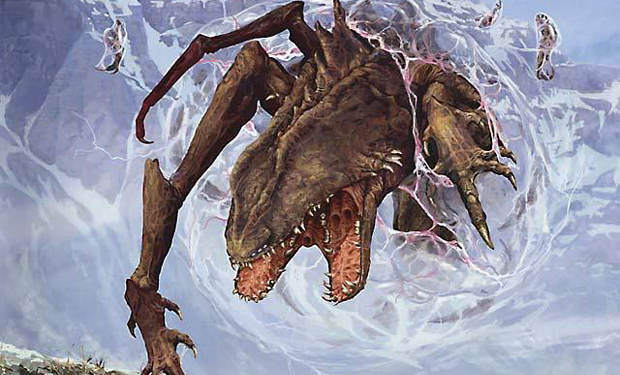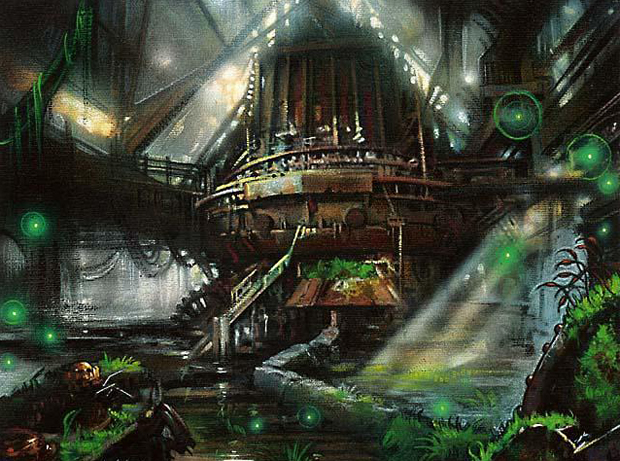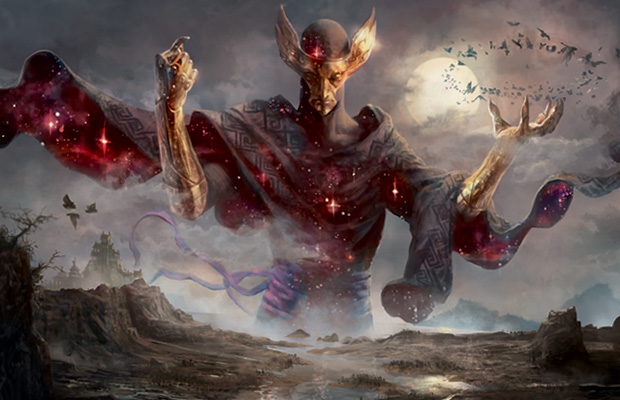By: Cliff Daigle
The consensus at the moment is that Born of the Gods lacks punch, panache, and power for constructed formats. It’s being lumped in with Dragon’s Maze, which is not where you want to be. That set had one chase mythic and a lot of chaff. (How good is Ral Zarek and Inspired, though?)
Beyond the letdown, there’s something else at work we need to pay attention to: the size of the set and the block.
Unless you’ve been playing this game since 2009’s Scars of Mirrodin block, you might not know that the ‘traditional’ structure of a block is Big Set – Small Set – Small Set. It’s been four years since Wizards did a block with the structure they have said is ‘normal’. It’s fair to say that a large part of the current player base has started playing after that point.
Scars block has seen a number of price spikes lately, especially mythics like Phyrexian Obliterator, Karn Liberated, and the popular casual cycle of the Praetors. Casual formats like EDH are also why Darksteel Plate is a $5 card. So many people have started playing Commander since 2009, it accounts for a large part of that price growth.
When the block structure changes, so does the draft environment and the economics of that set. Small sets can have cards that are highly sought after, but since only one of those packs is opened in a draft set, those cards are simply more scarce.
Let’s go to the numbers. For my examples, we’ll presume a small store that does three drafts in a month, and gets exactly eight people on those nights. We’ll talk about how the numbers scale in a moment.
Our model is a draft pod of eight people at one store, three drafts per month, three months per season. I’m not going to account for prize packs, since there’s such a wide range of prizes given out.
|
8 people in a draft |
3 drafts per month |
3 months in a season |
|
|
3 packs of Theros |
24 packs |
72 packs |
216 packs |
This is exactly what happens with the big fall set: We open lots of it! But what happens when we add the second set in a traditional structure?
|
8 people/draft |
3 drafts/month |
3 months/season |
|
|
1 pack of Born of the Gods |
8 packs |
24 packs |
72 packs |
|
2 packs of Theros |
16 packs |
48 packs |
144 packs |
The key here is not only are packs being opened at a 2:1 ratio for these three months, the big set was already exclusively opened for three months beforehand!
Now, the full block of Theros:
|
8 people/draft |
3 drafts/month |
3 months/season |
|
|
1 pack of Journey Into Nyx |
8 packs |
24 packs |
72 packs |
|
1 pack of Born of the Gods |
8 packs |
24 packs |
72 packs |
|
1 pack of Theros |
8 packs |
24 packs |
72 packs |
When we add it up the nine months of Theros block, the discrepancy is clear. In this basic example, this store will have opened 432 packs of Theros, 144 of Born of the Gods, and a mere 72 packs of Journey into Nyx.
Reducing that ratio (yes, let’s step back into middle school math) gives us a ratio of 6:2:1.
For every one pack of the third set, two of the middle set and six of the first are opened. Granted, this is only for draft, but sealed goes 3/3 and then 2/2/2, which isn’t a big swing, considering how many drafts happen vs. how many sealed events occur.
It doesn’t matter how many drafts are held, this ratio stays firm (so long as equal number of drafts occur during each season.) We will open three times as many Theros packs as we will of Born of the Gods, and we will open six times as many Theros packs as we will Journey into Nyx. Cards from those sets are much more likely to see big price spikes during their time in Standard – and beyond!
For comparison’s sake, let’s look at the ratio of the block we just finished:
|
Draft season |
Packs opened that season |
Totals opened at the end |
|
Return to Ravnica only |
216 RTR packs opened |
288 RTR packs |
|
Gatecrash only |
216 GTC packs opened |
288 GTC packs |
|
Full block (DGM-GTC-RTR) |
72 of each opened |
72 Dragon’s Maze packs |
Our ratio is now 4:4:1, and explains how all the shocklands have a similar price right now: we opened equal amounts of each of those set. Return to Ravnica block draft had one more issue: Modern Masters showed up at the end, and everyone who could draft that instead of RtR block did so.
To counteract the small-set effect somewhat, small sets have less cards. That means the chance of getting a Brimaz in your Born of the Gods pack is higher than getting a Jace, AoT in your Return to Ravnica pack. The number of mythics in a small set is five less, but when combined with the smaller number of packs, the small-set cards don’t keep up. When a small-set Mythic is popular and powerful, we get Huntmaster of the Fells at $40 before the end of its time in Standard. A hot new build featuring Voice of Resurgence would have a similar outcome.
With small sets opened in that ratio through the life of the block, and the smaller number of rares/mythics, chase cards are exactly that: a target. As a rough estimate, specific small-set cards are three to four times less likely to be opened at events. It’s not going to feel that way at a PTQ or GP, where it will seem like Gods and Brimaz abound at the top tables, but there it is.
Born of the Gods will have an extra three months of it being drafted compared to Journey into Nyx, though. That set will be even more impacted! There will be twice as much Born of the Gods opened as Journey into Nyx.
I admit there are factors here that I can’t account for. We aren’t told how many redemptions occur via Magic Online. We aren’t given hard data on the number of boxes sold, nor are we able to estimate how many boxes are opened just for the packs.
So what does this mean? What benefit do we gain from this knowledge?
First of all, if it’s borne out that Brimaz is the chase mythic and all else is chaff. Stock up on the scry lands from these two small sets. They will be much harder find than their Theros counterparts, and will be sought after during their time in standard. Don’t sleep on how good the scry lands are in EDH either – that’s going to lower the supply available.
The Gods of BotG face a similar path. All of them are good casual cards and make interesting decks as generals or in the ninety-nine. I’m looking for a few of them myself. They may not see much Standard play, but the smaller numbers and casual appeal will keep their prices from dipping too far. I’d anticipate that the five Gods of Journey into Nyx will be similarly impacted, though they will be half as available! (Side note: I’m trying to trade for Aurelia, the Warleader right now because it’s a safe bet that the Boros god, Iroas, will do something good for attackers, and a curve of Iroas into Aurelia will only need one other red or white card to turn on devotion and double attacks.)
After that, though, I don’t see much in Born of the Gods that will have players going crazy. It’s a set with a little something for everyone, filling a lot of niches. There’s exchanging control, random destruction, legendary benefits, a less-than-overpowered planeswalker, and a five-color, dear-lord-why-aren’t-you-a-legend mega-Bestow. There’s a lot of fun cards to try, but not many that will have a huge financial impact.
In the event that I’m wrong, please keep in mind that everything in these two small sets will have a severely diminished supply. We’ve got three months of Born-Theros-Theros drafts in front of us, so we’ll keep opening Master of Waves and Hero’s Downfall, but we won’t crack open many of the new Gods or the new scrylands.
Have fun at the release this weekend!



